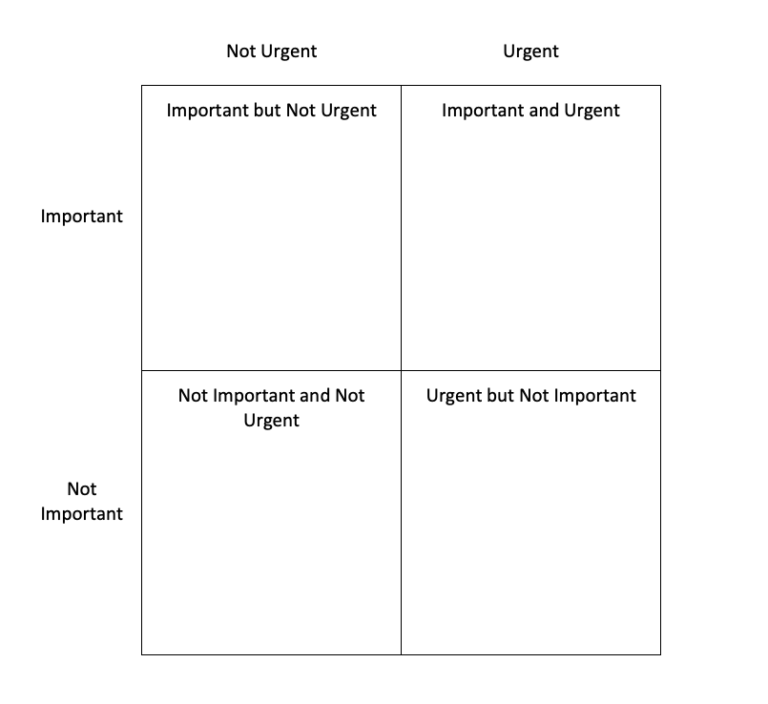What is the Eisenhower Method and How Do I Use It?
Scott Miller | Posted on |
Whether you’re knocking items off your to-do list at home or juggling competing responsibilities at work, a common question is, “what should I do first?” The Eisenhower Method can help you answer that question.
The Eisenhower Method is a tool to help us organize tasks and projects. It can be an effective tool for both individuals and teams. It focuses on two factors, urgency and importance, and lets us use these factors to plan our approach to different tasks.
Why is it called the “Eisenhower Method?”
During World War II, General Dwight D. Eisenhower served as Supreme Commander of the Allied Expeditionary Force in Europe. He later became the 34th President of the United States. Eisenhower once spoke about the difference between urgency and importance during a speech that he gave while President. That speech has been cited as the inspiration for this tool and the reason that it’s named after Eisenhower.
The tool is also known as the Eisenhower Matrix or the Eisenhower Principle.
How is urgency different from importance?
As the Beastie Boys once famously pointed out, fudge and caramel are not the same. Urgency and importance are not the same, either, but it’s easy to confuse the two. We describe a task as important when we really mean that it’s urgent, or vice versa. The Eisenhower Method helps us understand the difference.
In basic terms, urgency describes how quickly a task needs to be done. We can decide how urgent a task or project is by asking questions like these:
- If we do this at all, how soon does it need to be done?
- How soon does this need to be done in order to achieve the results we want?
- What happens if this isn’t done immediately?
- How long can we wait to do this and still achieve the desired results?
Importance is a way to describe the benefits that we’ll receive by completing a task or project. Two different people might have very different ways of deciding how important something is, and two different organizations might characterize importance in different ways. When deciding how important a task or project is, we might ask questions like these:
- How will I (or we) benefit from completing this task or project?
- How does this serve our immediate goals?
- How does this serve our long-term goals?
- What happens if this doesn’t get done at all?
Once we clearly understand the difference between urgency and importance, we can use the Eisenhower Method to prioritize tasks or projects.
How to use the Eisenhower Method
This exercise can easily be done on paper, with a whiteboard, or in a note-taking app like OneNote or Freeform. We’ll start by describing one way to use this yourself, individually. We’ll then look at a couple of variations, including ways to use this in a group setting.
1. Start by making a list of tasks that you want to complete. Don’t ask yourself, “what are my most urgent or important tasks?” Instead, make a list of all tasks that you plan to complete in a day, a week, or whatever timeframe you’re exploring.
2. Now draw a two-by-two matrix like the one below. Look closely at the diagram and make sure to label the boxes the same way.

3. Look at each task in your list, one at a time, and ask yourself two questions:
4. First, ask yourself if it is important or not. Should it go in one of the top two boxes (important), or in one of the bottom two (not important)?
5. Now, separately, ask yourself how urgent it is? Should it go in a box on the right side (urgent) or on the left (not urgent)?
6. Place the task in the appropriate box. You can either rewrite the task inside the box, or number each task on your list and write the number of the task in the appropriate box.
7. When you have placed each task in one of the boxes, take time to look at the two-by-two matrix. What do you see? What actions will you take based on what you see?
Drill down on importance and urgency:
When completing step #1 above, it’s okay to if everything on your list seems urgent and / or important. Just acknowledge, right from the start, that you’re doing the exercise that way.
During Step #3, you’ll ask “how important is this compared to other items on the list?” and “how urgent is this compared to other items on the list?” When everything seems important and urgent, this can be a good way to determine an item’s relative importance and urgency compared to other items.
Use the Eisenhower Matrix with a team:
Complete this as a group exercise. It often works best with a group of 10 people or fewer.
Create a list of tasks or projects that the team is working on. This list can be prepared in advance, or the group can create the list together at the start of the exercise.
Once you have a list of tasks, put the two-by-two matrix on a whiteboard or share it using a monitor so that everyone can see it.
In a virtual meeting, screen share the matrix.
Get input from each member of the group as you place each task or project in the appropriate location on the matrix. It can be helpful to quickly place each item on the matrix based on first impressions, without a lot of debate or discussion. Do this until you’ve gone through the entire list and placed every item on the matrix. Then, go back and review where you’ve placed each item. If anyone thinks that any items should be moved to a different box, let the group have a discussion about it.
Be sure to leave time in the meeting to discuss what actions your team will take based on the results of this exercise.
Are you or your team looking for ways to use your time more effectively? Schedule a free consultation to learn how Core Energy Coaching can help.
